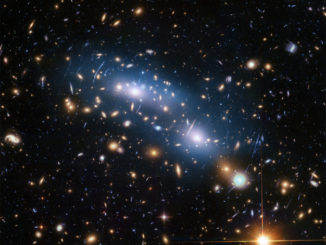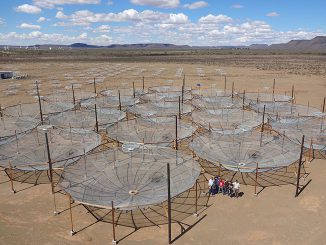
A new set of precision distance measurements made with an international collection of radio telescopes have greatly increased the likelihood that theorists need to revise the “standard model” that describes the fundamental nature of the Universe.
The new distance measurements allowed astronomers to refine their calculation of the Hubble Constant, the expansion rate of the Universe, a value important for testing the theoretical model describing the composition and evolution of the Universe. The problem is that the new measurements exacerbate a discrepancy between previously measured values of the Hubble Constant and the value predicted by the model when applied to measurements of the cosmic microwave background made by the Planck satellite.
“We find that galaxies are nearer than predicted by the standard model of cosmology, corroborating a problem identified in other types of distance measurements,” said James Braatz, of the National Radio Astronomy Observatory (NRAO). “There has been debate over whether this problem lies in the model itself or in the measurements used to test it.
“Our work uses a distance measurement technique completely independent of all others, and we reinforce the disparity between measured and predicted values. It is likely that the basic cosmological model involved in the predictions is the problem.”
Braatz leads the Megamaser Cosmology Project, an international effort to measure the Hubble Constant by finding galaxies with specific properties that lend themselves to yielding precise geometric distances.
Edwin Hubble, after whom the orbiting Hubble Space Telescope is named, first calculated the expansion rate of the universe (the Hubble Constant) in 1929 by measuring the distances to galaxies and their recession speeds. The more distant a galaxy is, the greater its recession speed from Earth. Today, the Hubble Constant remains a fundamental property of observational cosmology and a focus of many modern studies.
Measuring recession speeds of galaxies is relatively straightforward. Determining cosmic distances, however, has been a difficult task for astronomers. For objects in our own Milky Way Galaxy, astronomers can get distances by measuring the apparent shift in the object’s position when viewed from opposite sides of Earth’s orbit around the Sun, an effect called parallax. The first such measurement of a star’s parallax distance came in 1838.
Beyond our own Galaxy, parallaxes are too small to measure, so astronomers have relied on objects called “standard candles,” so named because their intrinsic brightness is presumed to be known. The distance to an object of known brightness can be calculated based on how dim the object appears from Earth. These standard candles include a class of stars called Cepheid variables and a specific type of stellar explosion called a Type Ia supernova.
Another method of estimating the expansion rate involves observing distant quasars whose light is bent by the gravitational effect of a foreground galaxy into multiple images. When the quasar varies in brightness, the change appears in the different images at different times. Measuring this time difference, along with calculations of the geometry of the light-bending, yields an estimate of the expansion rate.
Determinations of the Hubble Constant based on the standard candles and the gravitationally-lensed quasars have produced figures of 73-74 kilometres per second (the speed) per megaparsec (distance in units favoured by astronomers).
However, predictions of the Hubble Constant from the standard cosmological model when applied to measurements of the cosmic microwave background (CMB) — the leftover radiation from the Big Bang — produce a value of 67.4, a significant and troubling difference. This difference, which astronomers say is beyond the experimental errors in the observations, has serious implications for the standard model.
The Megamaser Cosmology Project focuses on galaxies with disks of water-bearing molecular gas orbiting supermassive black holes at the galaxies’ centres. If the orbiting disk is seen nearly edge-on from Earth, bright spots of radio emission, called masers — radio analogs to visible-light lasers — can be used to determine both the physical size of the disk and its angular extent, and therefore, through geometry, its distance. The project’s team uses the worldwide collection of radio telescopes to make the precision measurements required for this technique.
In their latest work, the team refined their distance measurements to four galaxies, at distances ranging from 168 million light-years to 431 million light-years. Combined with previous distance measurements of two other galaxies, their calculations produced a value for the Hubble Constant of 73.9 kilometers per second per megaparsec.
“Our measurement of the Hubble Constant is very close to other recent measurements, and statistically very different from the predictions based on the CMB and the standard cosmological model. All indications are that the standard model needs revision,” said Braatz.



